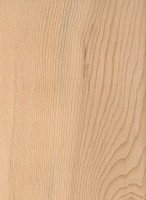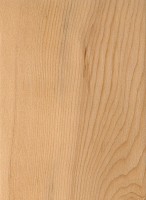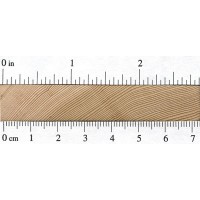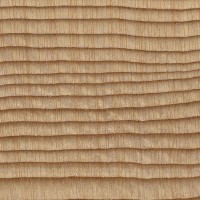 |
Common Name(s): Mountain Hemlock Scientific Name: Tsuga mertensiana Distribution: Northwest coast of North America Tree Size: 65-130 ft (30-40 m) tall, 3-4 ft (1-1.2 m) trunk diameter Average Dried Weight: 33 lbs/ft3 (530 kg/m3) Specific Gravity (Basic, 12% MC): .42, .53 Janka Hardness: 680 lbf (3,030 N) Modulus of Rupture: 11,500 lbf/in2 (79.3 MPa) Elastic Modulus: 1,330,000 lbf/in2 (9.17 MPa) Crushing Strength: 6,440 lbf/in2 (44.4 MPa) Shrinkage: Radial: 4.4%, Tangential: 7.1%, Volumetric: 11.1%, T/R Ratio: 1.6 |
Color/Appearance: Heartwood is light reddish brown. Sapwood may be slightly lighter in color but usually isn’t distinguished from the heartwood. The conspicuous growth rings can exhibit interesting grain patterns on flatsawn surfaces.
Grain/Texture: Grain is generally straight, with a coarse, uneven texture.
Endgrain: Resin canals absent; earlywood to latewood transition usually gradual, color contrast fairly high; tracheid diameter medium-large.
Rot Resistance: Rated as non-durable regarding decay resistance, and also susceptible to insect attack.
Workability: Overall working properties are good, but because of the disparity between the soft earlywood and the hard latewood, sanding can create dips and uneven surfaces. Glues, stains, and finishes well.
Odor: No characteristic odor.
Allergies/Toxicity: Mountain Hemlock has been reported to cause skin irritation. See the articles Wood Allergies and Toxicity and Wood Dust Safety for more information.
Pricing/Availability: Because many trees are difficult to access, Mountain Hemlock isn’t harvested nearly as extensively as its close relative, Western Hemlock, which is another hemlock species that is found in nearly the same geographic distribution. Mountain Hemlock is used for the same construction purposes as Western Hemlock; expect prices to be moderate for a domestic softwood.
Sustainability: This wood species is not listed in the CITES Appendices, and is reported by the IUCN as being a species of least concern.
Common Uses: Boxes, pallets, crates, plywood, framing, and other construction purposes.
Comments: Mountain Hemlock is slightly heavier and harder than the two primary hemlock species of North America (Eastern and Western Hemlock). When compared to Eastern Hemlock (Tsuga canadensis), Mountain Hemlock generally has narrower growth rings, though both species can have tightly spaced growth rings. (Mountain Hemlock is anatomically very similar to Western Hemlock.)
None available.







